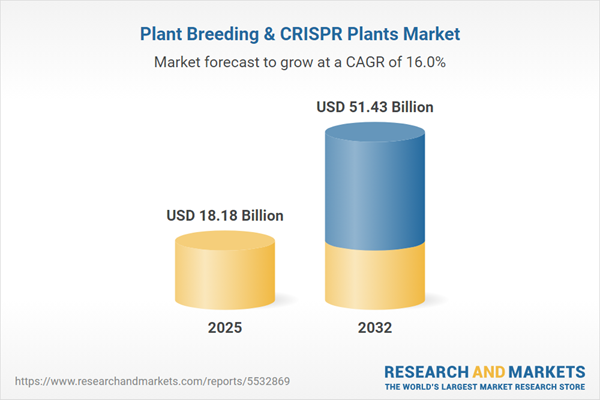Speak directly to the analyst to clarify any post sales queries you may have.
The Plant Breeding & CRISPR Plants Market is at a turning point, as senior decision-makers accelerate the adoption of gene editing and digital strategies to maintain operational leadership and strengthen compliance within evolving global regulations.
Market Snapshot: Plant Breeding & CRISPR Plants Market
Innovation continues to transform the Plant Breeding & CRISPR Plants Market. The sector is valued at USD 15.64 billion in 2024, with expectations to reach USD 18.18 billion in 2025 and USD 51.43 billion by 2032, registering a compound annual growth rate of 16.04%. Continuous integration of CRISPR systems with established breeding techniques enables improved efficiencies and proactive responses to regulatory requirements. Organizations embracing these advancements are well-placed to adapt and excel across changing industry landscapes, as they gain critical advantages in trait development and operational compliance.
Scope & Segmentation
This report provides in-depth strategic guidance to senior leadership, supporting the identification of emerging opportunities, enhanced risk mitigation, and value creation across the sector. Scope and segmentation insightfully address diverse market forces and critical segment drivers to inform executive strategy:
- Crop Types: Covers vital crops such as maize, soybeans, wheat, vegetables, and fruits, showing each crop’s contribution to food security and supply chain continuity.
- Technologies: Examines CRISPR/Cas9, CRISPR/Cas12, base editing, prime editing, Meganucleases, TALEN, ZFN, and ODM—outlining how these genome-editing tools accelerate precise trait improvements and compliance protocols.
- Traits: Focuses on key breeding priorities including stress tolerance, herbicide and insect resistance, and crop performance to reflect evolving sustainability standards and market preferences.
- End Users: Analyzes biotechnology firms, seed producers, academic organizations, contract research bodies, and governmental agencies that drive innovation from research to commercialization.
- Regions: Reviews Americas, Europe, Middle East & Africa, and Asia-Pacific, considering the effect of local regulations, policy trends, and investment flows on access and operational decision-making.
- Key Companies: Reports on strategies and innovation positioning of prominent organizations such as Bayer AG, Corteva, Syngenta AG, BASF SE, KWS SAAT, Limagrain Holding, Land O’Lakes, Calyxt, Pairwise Plants, and Inari Agriculture.
Key Takeaways for Senior Decision-Makers
- Advanced gene editing technologies combined with foundational breeding methods allow organizations to adapt quickly and shorten development cycles, resulting in resilient go-to-market strategies.
- Focused compliance and risk management frameworks streamline regional market entry and reinforce capacity to respond to shifting policies while maintaining operational agility.
- Collaboration with academic and public research entities expands innovation pipelines, drives technology transfer, and enhances internal skill sets for future-readiness.
- Aligning trait selection with both supply chain efficiency and user needs supports technology adoption and drives sustained competitive differentiation.
- Active participation in industry research initiatives enables early integration of genome-editing techniques, facilitating practical deployment at scale.
- Implementation of digital agronomic and remote sensing tools boosts resource optimization and delivers actionable analytics for improved production-cycle management.
Tariff and Trade Policy Impact
Market participants are reevaluating sourcing strategies in light of shifting U.S. tariff conditions, resulting in efforts to develop more resilient regional supplier networks. This adaptation enhances supply chain flexibility and enables quicker response to evolving international and domestic trade and regulatory requirements, ensuring organizations remain competitive and efficient under changing policy scenarios.
Methodology & Data Sources
Analysis is based on expert interviews, robust quantitative research, and broad reviews of academic and industry publications. Ongoing feedback from commercial, scientific, and regulatory stakeholders validates the relevance of findings and supports actionable recommendations for stakeholders across the plant breeding and gene editing value chain.
Why This Report Matters
- Provides actionable insights on the Plant Breeding & CRISPR Plants Market, supporting C-suite decision-making around technology advancement and regulatory adaptation.
- Supports best practice development for compliance and procurement, enabling organizations to enhance resilience amid evolving global and regional regulations.
- Links technology integration to improved supply chain efficiency, informing strategic planning and growth initiatives for competitive advantage.
Conclusion
This report equips leaders with strategic insights to guide technology adoption, boost collaboration, and proactively address evolving needs in plant breeding and gene editing.
Additional Product Information:
- Purchase of this report includes 1 year online access with quarterly updates.
- This report can be updated on request. Please contact our Customer Experience team using the Ask a Question widget on our website.
Table of Contents
3. Executive Summary
4. Market Overview
7. Cumulative Impact of Artificial Intelligence 2025
List of Figures
Companies Mentioned
The companies profiled in this Plant Breeding & CRISPR Plants market report include:- Bayer AG
- Corteva, Inc.
- Syngenta AG
- BASF SE
- KWS SAAT SE & Co. KGaA
- Limagrain Holding S.A.
- Land O'Lakes, Inc.
- Calyxt, Inc.
- Pairwise Plants, Inc.
- Inari Agriculture, Inc.
Table Information
| Report Attribute | Details |
|---|---|
| No. of Pages | 192 |
| Published | November 2025 |
| Forecast Period | 2025 - 2032 |
| Estimated Market Value ( USD | $ 18.18 Billion |
| Forecasted Market Value ( USD | $ 51.43 Billion |
| Compound Annual Growth Rate | 16.0% |
| Regions Covered | Global |
| No. of Companies Mentioned | 11 |









